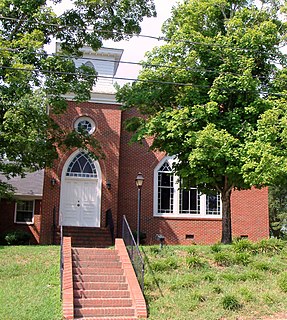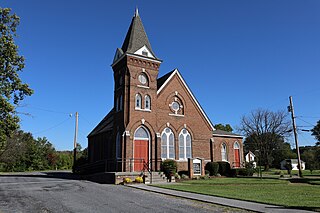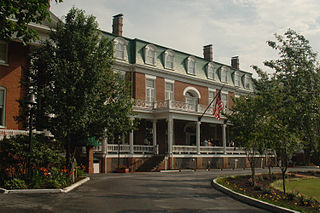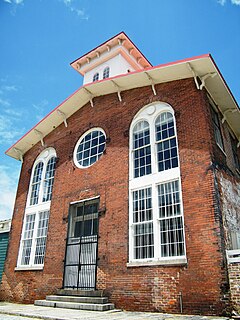
Cedar Bluff is a town in Tazewell County, Virginia, United States. The population was 1,139 at the 2010 census. It is part of the Bluefield, WV-VA micropolitan area, which has a population of 107,578.

The James River and Kanawha Canal was a partially built canal in Virginia intended to facilitate shipments of passengers and freight by water between the western counties of Virginia and the coast. Ultimately its towpath became the roadbed for a rail line following the same course.

Farmville Historic District is a national historic district located at Farmville, Prince Edward County, Virginia. It encompasses 246 contributing buildings and 1 contributing object in the central business district and surrounding residential areas of Farmville. It includes a variety of commercial, residential, institutional, and industrial buildings dating from the mid-19th to early-20th centuries. Notable buildings include the Paulett-Gill house, Farmville Presbyterian Church, Johns Memorial Episcopal Church (1881), Farmville Methodist Church (1907), Hotel Weyanoke (1925), the warehouses of the Dunnington Tobacco Company and Central Virginia Processing, Inc., the former Craddock-Terry Shoe Company, the former Cunningham and Company tobacco prizery, Norfolk and Western Railroad passenger station, Doyne Building, the Watkins M. Abbitt Federal Building (1917), Prince Edward County Courthouse, and the former Farmville High School (1913). Located in the district is the separately listed First Baptist Church.

Muddy Creek Mill is a historic grist mill complex and national historic district located in Tamworth, Cumberland County, Virginia. The district encompasses five contributing buildings and three contributing sites. The mill was built between 1785 and 1792, and is a large two-story structure with two half stories and rests on a down slope basement. It is constructed of sandstone, rubble masonry, and brick. Associated with the mill are a contributing brick store, early-19th century frame miller's house, late-18th century farmhouse and dairy, and the sites of a cooper's shop, blacksmith's shop and saw mill.

West Point Historic District is a national historic district located at West Point, King William County, Virginia. The district encompasses 75 contributing buildings and 1 contributing object in the town of West Point. The district includes residential, commercial, and institutional buildings and is notable for its variety of late-19th- and early-20th-century styles and building types. Notable buildings include the William Mitchell House, Anderson-Mayo House, Ware House, St. John's Episcopal Church (1882), Mt. Nebo Baptist Church (1887), West Point United Methodist Church (1889), O'Connor Hotel and annex, Treat-Medlin House (1898), Gouldman House (1923), First Baptist Church (1926), U.S. Post Office (1931), West Point Town Office Building, Citizens and Exchange Bank (1923), and Beverly Allen School (1930s).

Cifax Rural Historic District is a national historic district located near Cifax, Bedford County, Virginia. It encompasses 51 contributing buildings, 7 contributing sites, and 2 contributing structures. The district includes the dwellings and outbuildings of prominent families, the houses of the poor and middling farmers and the laborers who in part depended on them for employment, and the stores, schools, and churches that served them. Notable buildings include the Dillard-Coffey House, Logwood-Williams House, Old Nazareth Methodist Episcopal Church, Poplar Springs Baptist Church, Cifax School, The Cedars, Noell-Lankford House, Poindexter-Ellett-Higginbotham Farm, and Glen Alpine designed by architect Pendleton S. Clark with landscaping by Charles F. Gillette.

The Charlotte Court House Historic District is a national historic district located at Charlotte Court House, Charlotte County, Virginia. The district includes 46 contributing buildings, 2 contributing sites, 3 contributing structures, and 2 contributing objects in Charlotte Court House. The district is centered on the separately listed Charlotte County Courthouse. Other notable buildings include the former county jail (1936), Brick Tavern (1820), Charlotte County Farm Bureau building, St. John's Masonic Lodge (1852), Charlotte County Public Library, Village Presbyterian Church and cemetery (1835), Charlotte Court House United Methodist Church (1841), Diamond Hill, Villeview, W. B. Ramsey House, Charlotte County Elementary School (1908), and Randolph-Henry High School (1939–1940).

Long Marsh Run Rural Historic District is a national historic district located just outside Berryville, in Clarke County, Virginia. It encompasses 315 contributing buildings, 16 contributing sites, and 35 contributing structures. The district includes the agricultural landscape and architectural resources of an area distinctively rural that contains numerous large antebellum and postbellum estates, and several smaller 19th-century farms, churches, schools and African-American communities.

Markham Historic District is a national historic district located at Markham, Fauquier County, Virginia. It encompasses 44 contributing buildings and 4 contributing sites in the rural villages of Farrowsville and Markham. The majority of resources in the district were constructed in the mid- and late 19th century and include multiple dwellings, a hotel, as well as commercial buildings, and a train station. The district also contains early-20th-century dwellings. Notable buildings include Mountain View, Wolfs Crag, Rosebank, Markham School (1918), the 1819 stone Upper Goose Creek Church, and the former Markham Freight Station.

John Hite House, also known as Springdale, is a historic home located at Bartonsville, Frederick County, Virginia. The original house was built in 1753, and is of native limestone laid in irregular ashlar with some random-coursed limestone rubble used on its secondary walls. The stone was quarried from a nearby field. The house faced east, overlooking the Indian Trail/Great Valley Road, where Jost Hite's tavern was situated at the ford of the Opequon Creek. The Springdale property was originally the home of Jost Hite, the earliest white settler in the lower Shenandoah Valley. Jost Hite was Pennsylvania Dutch and moved to the Valley in August 1731. His son, Colonel John I. Hite, built the Springdale house. Also on the property are the contributing stone ruins of what is believed to be Jost Hite's tavern/house of the 1730s, a stone shed, and small wood-frame spring house. The house and 288 acres were sold March 20, 1802 to Richard Peters Barton (1763-1821), a native of Lancaster Pa. who had spent some years in Dinwiddie County, Va., before moving to Frederick County c. 1798. [Frederick County Deed Book S.C.4, p. 484.] The house passed to his son Richard Walker Barton (1799-1859) and in 1858 to another son, David Walker Barton (1801-1863), remaining in the Barton family until 1873. There is a small Barton family cemetery on the property. When the Valley Turnpike was chartered in 1834, the road was laid out to run on the west side of Springdale. Soon thereafter, the house was reoriented to face the Turnpike, and the Richard W. Bartons built the then-fashionable Greek Revival four-bay, two-story portico. [Garland W. Quarles, "Some Old Houses in Frederick County, Virginia", Winchester, 1990. Revised ed. PP. 131–135.]

Montpelier Historic District is a national historic district located at Montpelier, Hanover County, Virginia. The district includes 43 contributing buildings and 1 contributing site in the village of Montpelier. It includes residences, agricultural buildings, stores, businesses, a church, schools and libraries that illustrate the wide range of building types. Notable buildings include the old school (1876), Church of Our Savior (1882), Grange Hall (1899), Hobart Hardware, Montpelier School (1929), "Norway" House (1936), and "The Oaks" (1936). Located in the district and listed separately is the Sycamore Tavern, the only 18th-century building remaining in the district.

The Boydton Historic District is a national historic district located at Boydton, Mecklenburg County, Virginia. It encompasses 199 contributing buildings, 6 contributing sites, 6 contributing structure, and 2 contributing objects in the central business district and surrounding residential areas of the town of Boydton. Notable buildings include the municipal building (1905), the old jail (1870), the Beales, Bedinger, and Gregory, Inc. car dealership building (1918), Washington Tavern, Williams and Goode Bank (1908), Boydton Department Store (1935), Mecklenburg County Building Department (1949), Southside Regional Library (1939), Presbyterian Meeting House (1819), Saint James Episcopal Church (1840-1841), Boydton Baptist Church, Trinity Episcopal Church (1890s), "Cedar Crest" (1825), and "On the Hill" (1920), which was separately listed in 2015. Also located in the district and separately listed are the Boyd's Tavern and Mecklenburg County Courthouse.

Chatham Historic District is a national historic district located at Chatham, Pittsylvania County, Virginia. The district includes 188 contributing buildings, 2 contributing sites, and 1 contributing object in the central business district of the town of Chatham. The district includes a variety of government, commercial, residential, religious and educational buildings and structures dating from the early-19th century to the mid-20th century. At the center of the district is the separately listed Pittsylvania County Courthouse. Other notable buildings include the Judge Tredway House, Tunstall-Hargrave House, The Oaks (1832), Morea (1837), Hugh Weir House (1835), Planter's Bank, Thompson's Drug and Haberdashy Building, Corinth Christian Church, Emmanuel Episcopal Church (1881), Chatham Presbyterian Church (1886), Canada-Melton House, United States Post Office, Chatham High School, Chatham Elementary School (1925), Chatham Savings Bank, Masonic Temple, Collie Hotel/William Pitt Hotel, Beauty Plaza, and the Moses Building. Also located in the district and separately listed are the Clerk's Office, Bill's Diner, and Burnett's Diner.

Marion Historic District is a national historic district located at Marion, Smyth County, Virginia. The district includes 361 contributing buildings, 2 contributing sites, and 1 contributing object in the central business district and surrounding residential areas of Marion. It includes a variety of residential, commercial, institutional, industrial, and governmental buildings primarily dating from the mid-19th to mid-20th centuries. Notable buildings include the Sheffey Loom House, Odd Fellows Lodge, Look & Lincoln Wagon Factory warehouse, the Beaux-Arts style Marion County Courthouse (1905), Mt. Pleasant Methodist Church, Courtview Building (1890s), Marion High School (1907-1908), Marion Junior College (1912), the Overall Factory, Weiler Building, Bank of Marion (1922), Royal Oak Presbyterian Church (1923), Marion Municipal Building (1935), Marion Post Office (1936), and a Lustron house (1948). Also located in the district are the separately listed Hotel Lincoln, Lincoln Theatre, Marion Male Academy, and Norfolk & Western Railway Depot.

Riverton Historic District is a national historic district located at Front Royal, Warren County, Virginia. The district encompasses 66 contributing buildings and one contributing site in the town of Front Royal. It is a primarily residential district with buildings dating from the mid-19th century and including a diverse collection of building types and architectural styles. Notable buildings include Lackawanna (1869), the Old Duncan Hotel, the Riverton United Methodist Church (1883-1890), Dellbrook, the Carson Lime Company worker's houses, and the Old Riverton Post Office and Grocery. Located in the district and separately listed is Riverside.

Abingdon Historic District is a national historic district located at Abingdon, Washington County, Virginia. The district encompasses 145 contributing buildings, 2 contributing site, and 13 contributing structures in the town of Abingdon. It includes a variety of residential, commercial, and institutional buildings dating from the late-18th century to the mid-20th century. Notable contributing resources include Sinking Spring Cemetery, William King High School (1913), General Francis Preston House (1832), Martha Washington Inn, Barter Theatre, the Virginia House, Alexander Findlay House (1827), Gabriel Stickley House, Ann Berry House, Washington County Courthouse (1868), Rev. Charles Cummings House, and James Fields House (1857). Located in the district and separately listed are the Abingdon Bank and Dr. William H. Pitts House.

Petersburg Old Town Historic District is a national historic district located at Petersburg, Virginia. The district includes 174 contributing buildings located in the oldest section of Petersburg. It includes a varied collection of late 18th- through 20th-century architecture. Notable buildings include the Strachan-Harrison house, the John F. May house, South Side Railroad Depot, High Street United Methodist Church, Church of Christ (1925), and the Powell Manufacturing Co. Located in the district and separately listed are the Appomattox Iron Works, City Market, Exchange Building, Farmers' Bank and Nathaniel Friend House.

Folly Castle Historic District, also known as the West Washington Street Historic District, is a national historic district located at Petersburg, Virginia. The district includes 189 contributing buildings and 1 contributing object located in a predominantly residential section of Petersburg. It includes a varied collection of late 18th-and 19th-century houses and includes notable examples of Late Victorian, Georgian, Italianate, Queen Anne, and Federal style architecture. Notable buildings include Folly Castle / Peter Jones V residence, McIlwaine-Friend residence (1856-1858), Rambout-Donnan residence, former Petersburg High School (1917-1918), Donnan House, First Baptist Church (1928), Couch House (1850s), and St. John's Episcopal Church (1897). Located in the district and separately listed are the Second Presbyterian Church and Strawberry Hill.

Downtown Salem Historic District is a national historic district located at Salem, Virginia. The district encompasses 34 contributing buildings and 1 contributing site in downtown Salem. The district includes primarily mixed-use commercial buildings, but also includes churches, dwellings, a courthouse, a post office, a library, a park, and the covered stalls of a farmer's market. The buildings mostly date from the late-19th and early-20th century and are in a variety of popular architectural styles including Greek Revival, Italianate, and Queen Anne. Notable buildings include the Stevens House or "Old Post House" (1820s-1830s), Kizer-Webber Building (1883-1886), Duval-Oakey House (1891-1898), Salem High School, Old Salem Municipal Building and Fire Department (1925), Quality Bakery Building, Olde Newberry Building (1929), Salem Theater, and James J. True Building (1927). Located in the district are the separately listed Old Roanoke County Courthouse, Salem Presbyterian Church, and Salem Post Office.

Suffolk Historic District is a national historic district located at Suffolk, Virginia. The district encompasses 514 contributing buildings, 3 contributing structures, and 3 contributing objects in Suffolk. The district includes a variety of residential, commercial, governmental, and institutional buildings. They are in a variety of vernacular and popular 19th and 20th century architectural styles including Greek Revival, Queen Anne, and Bungalow. Notable buildings include the Allmond Building (1914), Macedonia A.M.E. Church, National Bank of Suffolk (1914-1920), the Old Post Office, old Nansemond County Courthouse, John Granberry house, Richard Seth Eley House (1878), Jones Building, Suffolk Towers, Virginia Apartments (1918-1920), Causey-Kendrick house (1882), Masonic Hall (1911), Suffolk High School (1922), Jefferson High School (1911), old Methodist Church (1861), St. Paul's Episcopal Church (1895), Suffolk Christian Church (1893), and Congregation of Agudath Achin. Located in the district are the separately listed Phoenix Bank of Nansemond, Professional Building, and Riddick House.
























